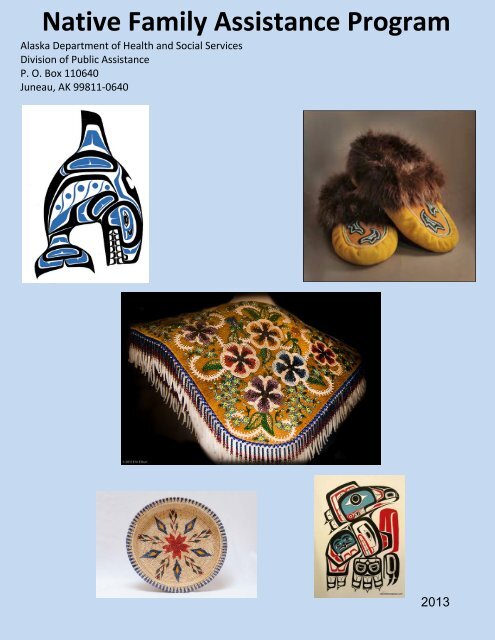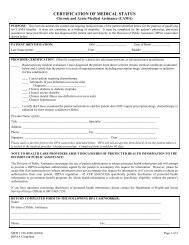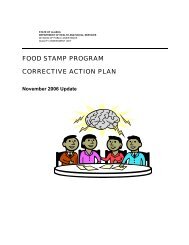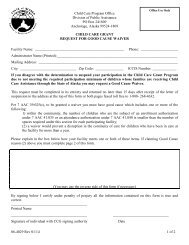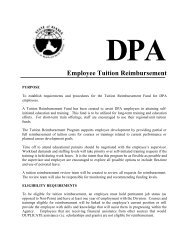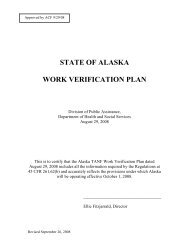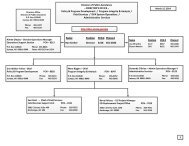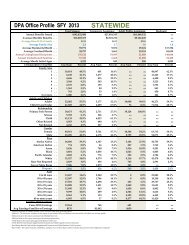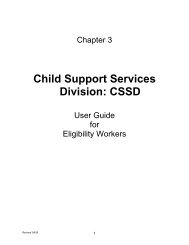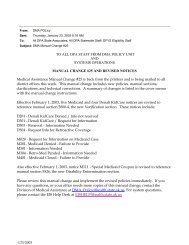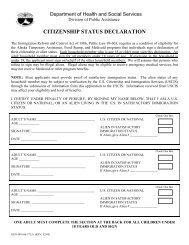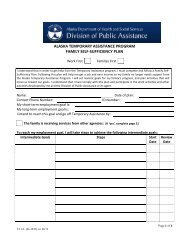Native Family Assistance Program Guide - DPAweb - Alaska ...
Native Family Assistance Program Guide - DPAweb - Alaska ...
Native Family Assistance Program Guide - DPAweb - Alaska ...
You also want an ePaper? Increase the reach of your titles
YUMPU automatically turns print PDFs into web optimized ePapers that Google loves.
<strong>Native</strong> <strong>Family</strong> <strong>Assistance</strong> <strong>Program</strong><strong>Alaska</strong> Department of Health and Social ServicesDivision of Public <strong>Assistance</strong>P. O. Box 110640Juneau, AK 99811-064012013
2<strong>Native</strong> <strong>Family</strong> <strong>Assistance</strong> <strong>Program</strong> <strong>Guide</strong> Revised 12/11/12
NATIVE FAMILY ASSISTANCEPROGRAM GUIDE<strong>Alaska</strong> Department of Health and Social ServicesDivision of Public <strong>Assistance</strong>P.O. Box 110640Juneau, AK 99911-06402013IntroductionThe Personal Responsibility and Work Opportunity Reconciliation Act of 1996(PRWORA), commonly known as welfare reform, ended the entitlement to welfare cashbenefits under the Aid to Families with Dependent Children (AFDC) program, andcreated the Temporary <strong>Assistance</strong> for Needy Families (TANF) program.In addition to establishing a fixed block grant that caps the amount of federal fundingavailable for TANF and creating time limits on assistance, PRWORA gives AmericanIndians and certain <strong>Alaska</strong> <strong>Native</strong> Organizations the authority to design and operatetheir own TANF programs. Like state agencies, <strong>Native</strong> Organizations are given greatlatitude in administering TANF, setting eligibility criteria, delivering services, and usingfederal TANF funds to promote activities that support self-sufficiency.In <strong>Alaska</strong>, the authority to operate <strong>Native</strong> TANF programs is given to the following<strong>Alaska</strong> <strong>Native</strong> Organizations:• Arctic Slope <strong>Native</strong> Association• Kawerak, Inc.• Maniilaq Association• Association of Village Council Presidents• Tanana Chiefs Conference• Cook Inlet Tribal Council• Bristol Bay <strong>Native</strong> Association• Aleutian and Pribilof Islands Association• Chugachmiut• Tlingit and Haida Central Council• Kodiak Area <strong>Native</strong> Association• Copper River <strong>Native</strong> Association• Metlakatla Indian Community of the Annette Islands Reserve3<strong>Native</strong> <strong>Family</strong> <strong>Assistance</strong> <strong>Program</strong> <strong>Guide</strong> Revised 12/11/12
BackgroundFrom the outset, the State of <strong>Alaska</strong> has supported the establishment and developmentof <strong>Native</strong> TANF programs and has been committed to collaboration in the delivery ofservices to needy families applying for public assistance (TANF, Food Stamps, AdultPublic <strong>Assistance</strong> and Medicaid). In October 1998, the Tanana Chiefs Conference(TCC) began the first <strong>Native</strong> <strong>Family</strong> <strong>Assistance</strong> <strong>Program</strong> in <strong>Alaska</strong>. At that time, theDivision of Public <strong>Assistance</strong> (DPA) partnered with TCC and through a demonstrationmodel was able to grant state funding to TCC to supplement their federal TANF blockgrant. TCC established a “significantly similar” program and used the same eligibilityrules as the <strong>Alaska</strong> Temporary <strong>Assistance</strong> <strong>Program</strong> (ATAP).Building on TCC’s success, in 2000 the 21 st <strong>Alaska</strong> Legislature passed a law allowingthe Department of Health and Social Services (DHSS) to award <strong>Alaska</strong> <strong>Native</strong> <strong>Family</strong><strong>Assistance</strong> grants on a temporary pilot program basis to four <strong>Alaska</strong> <strong>Native</strong>Organizations: Association of Village Council Presidents (AVCP), Central Council ofTlingit and Haida Indian Tribes of <strong>Alaska</strong> (T&H), Tanana Chiefs Conference (TCC), andMetlakatla Indian Community. AVCP, TCC, and T&H chose to take advantage of thepilot program. Instead of requiring the <strong>Native</strong> Organizations to follow the same eligibilityrules as ATAP, the legislation allowed state funding for <strong>Native</strong> <strong>Family</strong> <strong>Assistance</strong><strong>Program</strong>s that were comparable to ATAP; the program rules no longer had to be thesame as ATAP.In 2005, the 24 th <strong>Alaska</strong> Legislature further acknowledged the achievements of the pilotprograms by passing a law that made the <strong>Native</strong> <strong>Family</strong> <strong>Assistance</strong> <strong>Program</strong>permanent. The law was also amended to expand the availability of <strong>Native</strong> <strong>Family</strong><strong>Assistance</strong> grants to all of the 13 <strong>Native</strong> Organizations listed above that are authorizedin the federal law to operate <strong>Native</strong> TANF programs.<strong>Alaska</strong>’s <strong>Native</strong> <strong>Family</strong> <strong>Assistance</strong> <strong>Program</strong>sAs a result of this change in law in 2005, four more <strong>Native</strong> Organizations beganoperating <strong>Native</strong> <strong>Family</strong> <strong>Assistance</strong> <strong>Program</strong>s: Cook Inlet Tribal Council Incorporated,Bristol Bay <strong>Native</strong> Association, Kodiak Area <strong>Native</strong> Association, and Maniilaq Area<strong>Native</strong> Association.There are currently seven <strong>Native</strong> <strong>Family</strong> <strong>Assistance</strong> <strong>Program</strong>s operating in <strong>Alaska</strong>. Theseven existing <strong>Native</strong> Organizations and their beginning dates of operation are:4<strong>Native</strong> <strong>Family</strong> <strong>Assistance</strong> <strong>Program</strong> <strong>Guide</strong> Revised 12/11/12
Tribal TANF Organizations in <strong>Alaska</strong>BeginningDate of Operation• TCC (Tanana Chiefs Conference) October 1998• T&H (Central Council of Tlingit and Haida Indian Tribesof <strong>Alaska</strong>)July 2000• AVCP (Association of Village Council Presidents) October 2000• CITCI (Cook Inlet Tribal Council)• BBNA (Bristol Bay <strong>Native</strong> Association)• KANA (Kodiak Area <strong>Native</strong> Association)• Maniilaq (Maniilaq Area <strong>Native</strong> Association)July 2005October 2006January 2009July 2009<strong>Alaska</strong>’s Comparability CriteriaTribal TANF is authorized by the Personal Responsibility and Work OpportunityReconciliation Act (PRWORA) of 1996, and reauthorized by the Deficit Reduction Act of2005. PRWORA includes a special rule for <strong>Alaska</strong> requiring <strong>Native</strong> Organizations to runprograms comparable to the <strong>Alaska</strong> Temporary <strong>Assistance</strong> <strong>Program</strong>. The U.S.Department of Health and Human Services, Administration for Children and Families(ACF), in consultation with the <strong>Native</strong> Organizations and the State of <strong>Alaska</strong> establishedfive “comparability criteria.” <strong>Alaska</strong>’s comparability criteria are as follows:1. Only families with at least one dependent child or a woman in the last trimesterof pregnancy are eligible for assistance;2. Benefit payments to eligible families may not exceed the amounts allowedunder the <strong>Alaska</strong> Temporary <strong>Assistance</strong> <strong>Program</strong>;3. To remain eligible for assistance, any minor parent of a dependent child must• Reside with a parent, legal guardian, or other adult relative, or in anadult-supervised supportive living arrangement,• Agree to have their cash benefit paid to their parent, legal guardian, oradult relative, or if applicable, to the adult head of an adult-supervised5<strong>Native</strong> <strong>Family</strong> <strong>Assistance</strong> <strong>Program</strong> <strong>Guide</strong> Revised 12/11/12
supportive living arrangement, and• Maintain attendance in a high school or other appropriate trainingprogram, unless the minor parent has a high school diploma or generalequivalent diploma.4. Families receiving assistance must participate in approved work activitieswithin 24 months or sooner, unless the participant is exempt from work activityrequirements.5. Families receiving assistance must cooperate with the <strong>Native</strong> TANF programand the <strong>Alaska</strong> Child Support Services Division (CSSD) or their <strong>Native</strong>Organization (when the <strong>Native</strong> Organization operates a child supportenforcement program) in their efforts to establish paternity and to establish,modify, or enforce a child support order for a dependent child in the assistanceunit. A <strong>Native</strong> TANF program applicant may not begin to receive benefits until heor she has assigned all rights to child support to the <strong>Native</strong> Organizationoperating a TANF program for the period for which benefits are paid.FundingTo receive federal funding to operate a <strong>Native</strong> TANF program in <strong>Alaska</strong>, and to receivea <strong>Native</strong> <strong>Family</strong> <strong>Assistance</strong> grant from DPA, <strong>Native</strong> Organizations must submit a federalTANF plan that complies with the comparability requirements described above.The <strong>Native</strong> Organization and DPA begin their collaboration at this juncture. DPAprovides staff resources and policy expertise to the <strong>Native</strong> Organization from the pointof receiving their Letter of Intent, through ACF approval of their <strong>Native</strong> <strong>Family</strong><strong>Assistance</strong> <strong>Program</strong> Plan, to program implementation and the first months of servicedelivery. This collaboration results in a <strong>Native</strong> <strong>Family</strong> <strong>Assistance</strong> <strong>Program</strong> that isgeographically and culturally customized, while still meeting all comparabilityrequirements.In order for most <strong>Native</strong> Organizations to successfully operate state-comparableprograms, they require both federal and state financial support. <strong>Native</strong> Organizationsoperating NFAPs receive their federal TANF block grant directly from ACF. The amountof the block grant is based on the total expenditures the state spent under the AFDCprogram in federal fiscal year 1994 to provide assistance and services to AmericanIndian and <strong>Alaska</strong> <strong>Native</strong> families living in a <strong>Native</strong> Organization’s service area.DPA’s state grant issued to <strong>Native</strong> Organizations operating <strong>Native</strong> <strong>Family</strong> <strong>Assistance</strong><strong>Program</strong>s supplements their federal TANF block grant. The <strong>Native</strong> Organization mayuse their federal funding to provide a wide array of services to eligible families, as longas the services meet one of the primary purposes of TANF. Conversely, the <strong>Native</strong>6<strong>Native</strong> <strong>Family</strong> <strong>Assistance</strong> <strong>Program</strong> <strong>Guide</strong> Revised 12/11/12
Organizations may only use their state grant for the purposes of paying cash assistanceand supportive services to eligible families.Service Population/Service Area<strong>Native</strong> Organizations operating <strong>Native</strong> <strong>Family</strong> <strong>Assistance</strong> <strong>Program</strong>s in <strong>Alaska</strong> serves aspecific population and operates within a specific region of the state. They must complywith the comparability requirement of providing TANF only to eligible families in whichthere is one caretaker relative and a minor child or a pregnant woman in her thirdtrimester. However, with approval from ACF and the state, the <strong>Native</strong> Organization mayelect to provide services to all eligible families within their service area, to only eligible<strong>Native</strong> families, or to other variances of a service population.Shown below are the service populations and service areas for each <strong>Native</strong> <strong>Family</strong><strong>Assistance</strong> <strong>Program</strong>. Service population terms are defined in varying definitions, asdescribed in their specific TANF plan.7<strong>Native</strong> <strong>Family</strong> <strong>Assistance</strong> <strong>Program</strong> <strong>Guide</strong> Revised 12/11/12
Tanana Chiefs Conference (TCC) “Athabascan Self-Sufficiency<strong>Assistance</strong> Partnership <strong>Program</strong>” (ASAP)http://www.tananachiefs.org/index.aspAddress: Tanana Chiefs Conference122 First Avenue, Suite 600Fairbanks, AK 99701Contact Information:Anita Taylor(907) 452-8251ext 3390Toll Free 1-800-478-6822anita.taylor@tananachiefs.orgRoxanne Sourapas-Lincoln(907) 452-8251ext 3355Toll Free 1-800-478-6822Roxanne.Sourapas@tananachiefs.orgService Population. TCC’s ASAP program serves eligible families in which the headof the household is an enrolled member of, or eligible for enrollment in, a federallyrecognized tribe. In two-parent families, one person must be designated as the head ofthe household. TCC will serve the family if the head of the two-parent household isenrolled or is eligible to be enrolled in a federally recognized tribe.Service Area. The service area for TCC’s <strong>Native</strong> <strong>Family</strong> <strong>Assistance</strong> <strong>Program</strong> includesFairbanks and surrounding communities within the Doyon Region of Interior <strong>Alaska</strong>.Communities in this service area include:AlatnaAlcanCircleCircle Hot SpringsGraylingHealyNulatoRampartAllakaket Cold Foot Healy Lake RubyAnvik Delta Junction Holy Cross ShagelukArctic Village Dot Lake Hughes Stevens VillageBeaver Dry Creek Huslia TakotnaBettles Eagle Kaltag TanacrossBig Delta Eagle Village Koyukuk TananaBirch Creek Ester Manley TelidaBoundary Evansville McGrath TetlinCentral Fairbanks Minto Tetlin JunctionChalkyitsik Fort Yukon Nenana TokChena Hot Springs Fox Nikolai VenetieChicken Galena Northway Wiseman8<strong>Native</strong> <strong>Family</strong> <strong>Assistance</strong> <strong>Program</strong> <strong>Guide</strong> Revised 12/11/12
Tlingit & Haida Central Council (T&H) Temporary <strong>Assistance</strong> for<strong>Native</strong> Families <strong>Program</strong> (TANF)http://www.ccthita.org/Address: Tlingit & Haida Central Council9109 Mendenhall Mall Blvd., Suite 8Juneau, AK 99801(907) 586-1432Contact Information:Shawn Guthrie, (907) 463-7314Brenda Chapman, (907) 463-7158(907) 463-7344bchapman@CCTHITA.orgGeorgia FineauService Population. The T&H TANF program serves eligible families in which theperson that makes the application is the head of the household, and at the time ofapplication is enrolled, or is eligible to be enrolled, in CCTHITA or a federally recognizedtribe.Eligibility does not exist if the individual that makes the application is not the head of thehousehold and an enrolled tribal member. In a family where one parent is <strong>Native</strong> andone is Non-<strong>Native</strong>, the family will receive services from either DPA or T&H dependingon which member was designated head of household and applied for services. Oncethe family selects their service provider, they remain with that service provider for theduration of their time on assistance.Service Area. The T&H <strong>Native</strong> <strong>Family</strong> <strong>Assistance</strong> <strong>Program</strong> serves all communitieswithin the Sealaska Region of Southeast <strong>Alaska</strong>, except Metlakatla. Communitieswithin this service area include:Angoon Haines Klawock SitkaAuke Bay Hollis Klukwan SkagwayCoffman Cove Hoonah Pelican Tenakee SpringsCraig Hydaberg Petersburg Thorne BayDouglas Juneau Point Baker Whale PassEdna Bay Kake Port Alexander WrangellElfin Cove Kasaan Port Protection YakutatGustavus Ketchikan Saxman9<strong>Native</strong> <strong>Family</strong> <strong>Assistance</strong> <strong>Program</strong> <strong>Guide</strong> Revised 12/11/12
Association of Village Council Presidents (AVCP) TANF <strong>Program</strong>http://www.avcp.org/Address: Association of Village CouncilPresidentsP.O. Box 219Bethel, AK 99559Contact Information:Jolene Geerhart, (907) 543-7401jgeerhart@avcp.orgDelbert Egoak, (907) 543-7319degoak@avcp.orgService Population. AVCP operates a TANF program providing temporary assistanceand related services to all eligible families within its service area, including both <strong>Native</strong>and non-<strong>Native</strong> families.Service Area. The service area for this program includes Bethel and surroundingcommunities within the Calista Region of Western <strong>Alaska</strong>. Communities in this servicearea include:Akiachak Emmonak Marshall Pitka’s PointAkiak Georgetown Mekoryuk PlatinumAlakanak Goodnews Bay Mountain Village QuinhagakAndreafsky Hamilton Napakiak Red DevilAniak Hooper Bay Napaimiut Russian MissionAtmautluak Lower Kalskag Napaskiak Scammon BayBethel Upper Kalskag Newtok SleetmuteBill Moore’s Slough Kasigluk Nightmute Saint Mary’sChefornak Kipnuk Nunam Iqua Stony RiverChevak Kongiganak Nunapitchuk Toksook BayChaloonawick Kotlik Ohogamiut TuluksakCrooked Creek Kwethluk Oscarville TuntutuliakChuathbaluk Kwigillingok Paimut TununakEek Lime Village Pilot Station Umkumiut10<strong>Native</strong> <strong>Family</strong> <strong>Assistance</strong> <strong>Program</strong> <strong>Guide</strong> Revised 12/11/12
Cook Inlet Tribal Council Inc. (CITCI) TANF <strong>Program</strong>http://www.citci.com/Address: Cook Inlet Tribal Council3600 San Jeronimo DriveAnchorage, AK 99508Contact Information:Holly Snowball Morales, (907) 793-3323hmorales@CITCI.orgCarol Wren, (907)793-3301Sherry Li’Aven, (907) 793-3346Service Population. The CITCI TANF program serves the following families:• Child-only cases in which at least one child is an enrolled member in a federallyrecognized tribe;• Two-parent families in which at least one parent is an enrolled member in afederally recognized tribe; and• Single-caretaker families in which the caretaker is an enrolled member in afederally recognized tribe.Service Area The service area for this program is the Municipality of Anchorage. TheMunicipality of Anchorage includes the following communities:Anchorage Eklutna Peters CreekChugiakGirdwoodEagle RiverIndian11<strong>Native</strong> <strong>Family</strong> <strong>Assistance</strong> <strong>Program</strong> <strong>Guide</strong> Revised 12/11/12
Bristol Bay <strong>Native</strong> Association (BBNA) Tribal TANFhttp://www.bbna.com/Address: Bristol Bay <strong>Native</strong> AssociationP.O. Box 310Dillingham, AK 99576Contact Information:Marlene Andrews, (907) 842-2262mandrews@bbna.comRae Belle Whitcomb, fax (907) 842-2262rwhitcomb@bbna.comService Population BBNA operates a TANF program providing temporary assistanceand related services to all eligible families within the Bristol Bay service area, includingboth <strong>Native</strong> and Non-<strong>Native</strong> families.Service Area The geographic boundary for the service area is contiguous with theBristol Bay Region established by the <strong>Alaska</strong> <strong>Native</strong> Claims Settlement Act of 1971.The villages of Bristol Bay include:AleknagikChignik BayChignik LagoonChignik LakeClarks PointCuryungEgegikEkukEkwokIgiugigIliamnaIvanof BayKanatakKokhanokKoliganekKing SalmonLevelockManokotakNaknekNewhalenNew StuyahokNondaltonPedro BayPerryvillePilot PointPortage CreekPort HeidenSouth NaknekTogiakTwin HillsUgashik12<strong>Native</strong> <strong>Family</strong> <strong>Assistance</strong> <strong>Program</strong> <strong>Guide</strong> Revised 12/11/12
Kodiak Area <strong>Native</strong> Association (KANA) Tribal TANFhttp://www.kanaweb.org/Address: Kodiak Area <strong>Native</strong> Association3449 Rezanof DriveKodiak, AK 99615Contact Information:Gwen Sargent, (907) 486-1361gwen.sargent@kanaweb.orgAnita Bailor, (907) 486-9806Amber Koning-Still (907) 486-9843Amber.koning-still@kanaweb.orgService Population Kodiak Area <strong>Native</strong> Association serves all eligible <strong>Native</strong> familieswithin the Koniag region, in which the head of the household is an enrolled member of,or is eligible for enrollment in, a federally recognized tribe. In two-parent families, oneperson must be designated as the head of the household. KANA will serve the family ifthe head of the two-parent household is enrolled, or is eligible to be enrolled in afederally recognized tribe.Service Area KANA serves all communities located in the Koniag region of the KodiakIsland Archipelago. Communities within the archipelago include:AkhiokKarlukKodiakLarsen BayOld HarborOuzinkiePort Lions13<strong>Native</strong> <strong>Family</strong> <strong>Assistance</strong> <strong>Program</strong> <strong>Guide</strong> Revised 12/11/12
Maniilaq Area <strong>Native</strong> Association (Maniilaq)Tribal TANF <strong>Assistance</strong>http://www.maniilaq.org/companyInfo.htmlAddress: Maniilaq Area <strong>Native</strong>AssociationP.O. Box 256Kotzebue, <strong>Alaska</strong> 99752(907) 442-7021Contact Information:Tanya Kirk, (907) 485-2162Tanya.kirk@maniilaq.orgKelli Gallahorn, (907) 442-7693Kelli.gallahorn@maniilaq.orgBarbara Janitscheck, (907) 442-7879Tribal Government ServicesAdministratorService Population Maniilaq Association operates a TANF program providingtemporary assistance and related services to all eligible families within the Maniilaqservice area, including both <strong>Native</strong> and Non-<strong>Native</strong> families.Service Area The Maniilaq service area is contiguous with the Northwest ArcticBorough. Communities include:AmblerBucklandDeeringKianaKivalinaKobukKotzebueNoatakNoorvikSelawikShungnak14<strong>Native</strong> <strong>Family</strong> <strong>Assistance</strong> <strong>Program</strong> <strong>Guide</strong> Revised 12/11/12
Information ExchangeThe grant agreements between the State of <strong>Alaska</strong> DHSS and <strong>Native</strong> Organizationsoperating <strong>Native</strong> <strong>Family</strong> <strong>Assistance</strong> <strong>Program</strong>s (NFAPs) contain specific languageregarding service coordination and exchange of information. A signed release ofinformation form is not needed to share information with NFAP employees about mutualclients. CITCI uses DPA’s Eligibility Information System (EIS) to determine eligibilityand authorize cash assistance. AVCP, TCC, T&H, BBNA, KANA and Maniilaq haveread-only access to EIS. Like DPA staff, NFAP staff must read DPA’s Security Manual,complete security agreements, agree to safeguard client information, comply with Stateof <strong>Alaska</strong> laws and regulations governing the confidentiality and use and disclosure ofpublic assistance records, and are subject to the penalties associated with misuse ofinformation.NFAPs negotiate and secure separate data exchange and memoranda of agreementswith the Department of Labor and Workforce Development, Permanent Fund DividendDivision, and the Social Security Administration, permitting information exchange anduse of interfaces.Joint Case ProcessingSpecial instructions for NFAP and DPA case processing procedures are located in theAdministrative Procedures Manual section 116.http://dpaweb.hss.state.ak.us/manuals/admin/apm.htm The section includes informationon accepting and processing applications, change reporting, transferring cases, andother processes pertinent to the exchange of information and data between the NFAPsand DPA which affects other assistance programs such as Food Stamps and Medicaid.The collaboration and coordination between DPA and the NFAPs is critical to providingassistance to all <strong>Alaska</strong>ns in need. It is important to keep open lines of communicationto maximize client service, administrative efficiency, and ensure timeliness andaccuracy of eligibility and payment determinations.Special CircumstancesA family who is eligible to be served by a <strong>Native</strong> <strong>Family</strong> <strong>Assistance</strong> <strong>Program</strong> mayrequest to be served by ATAP, when the family demonstrates “special circumstances”exist. “Special circumstances” may exist when an individual chooses not to claim atribal affiliation, and has not previously received tribal services. Please see TA MS 710-4 A. for more information on Special Circumstances, or e-mail the Policy & <strong>Program</strong>Development Team at DPAPOLICY@alaska.gov.Note: The <strong>Alaska</strong> <strong>Native</strong> <strong>Family</strong> <strong>Assistance</strong> <strong>Program</strong>s have great flexibility underfederal and state law to establish the eligibility requirements for their programs. Thesemay differ from those provided under the State's <strong>Alaska</strong> Temporary <strong>Assistance</strong>15<strong>Native</strong> <strong>Family</strong> <strong>Assistance</strong> <strong>Program</strong> <strong>Guide</strong> Revised 12/11/12
<strong>Program</strong>. The different eligibility rules do not constitute a "special circumstance" thatwould support the individual receiving benefits from the State's program, when theyotherwise met the requirements to be served by the <strong>Native</strong> program.Example: A <strong>Native</strong> family is penalized under a <strong>Native</strong> <strong>Family</strong> <strong>Assistance</strong><strong>Program</strong> because of non-compliance with their <strong>Family</strong> Self-Sufficiency Plan.The <strong>Native</strong> <strong>Family</strong> <strong>Assistance</strong> <strong>Program</strong> requires an adult family member toparticipate in parent-teacher conferences. The <strong>Alaska</strong> Temporary <strong>Assistance</strong>program has no similar provision. Although the family could receive a higherbenefit payment if they were to be served by the State’s program, they are stillpart of the <strong>Native</strong> <strong>Family</strong> <strong>Assistance</strong> <strong>Program</strong>’s service population, and must beserved by that program. The family’s failure to comply with the FSSP requirementdoes not constitute a special circumstance.Effects of the <strong>Native</strong> <strong>Family</strong> <strong>Assistance</strong> <strong>Program</strong>on Other DPA <strong>Program</strong>sIn addition to DPA’s Administrative Procedures Manual, the <strong>Alaska</strong> Temporary<strong>Assistance</strong> manual and <strong>Alaska</strong> Food Stamp program policy manuals include additionalpolicies and processing instructions to guide application and case processing forfamilies receiving assistance from a <strong>Native</strong> <strong>Family</strong> <strong>Assistance</strong> <strong>Program</strong>. For additionalinformation please refer to:ATAP Manual Sections701-1B. Who The 60 Months Limits Apply To701-1C. Months That Count Towards The 60-Month Time Limit705 Application Process705-2A. What Is An Acceptable Application Form?705-2B. When Is An Application Required?705-2G. Completing the Application Form705-3C. Who Can Conduct The Interview?705-3G. Do Disqualifications or Penalties Apply?705-5B. Benefit Start Date710-4 <strong>Native</strong> <strong>Family</strong> <strong>Assistance</strong> <strong>Program</strong>s and Eligibility for <strong>Alaska</strong> Temporary<strong>Assistance</strong>Food Stamp Manual Sections601 Application Process601-2.A What is an Acceptable Application Form?601-3.C Who Can Conduct the Interview?601-5.B Benefit Start Date602-1.G3 Special Provisions for Adults Subject to TANF Work RequirementsSubmit any requests for policy clarifications to the DPA Policy and <strong>Program</strong>Development Team at: DPAPOLICY@alaska.gov.16<strong>Native</strong> <strong>Family</strong> <strong>Assistance</strong> <strong>Program</strong> <strong>Guide</strong> Revised 12/11/12
17<strong>Native</strong> <strong>Family</strong> <strong>Assistance</strong> <strong>Program</strong> <strong>Guide</strong> Revised 12/11/12


